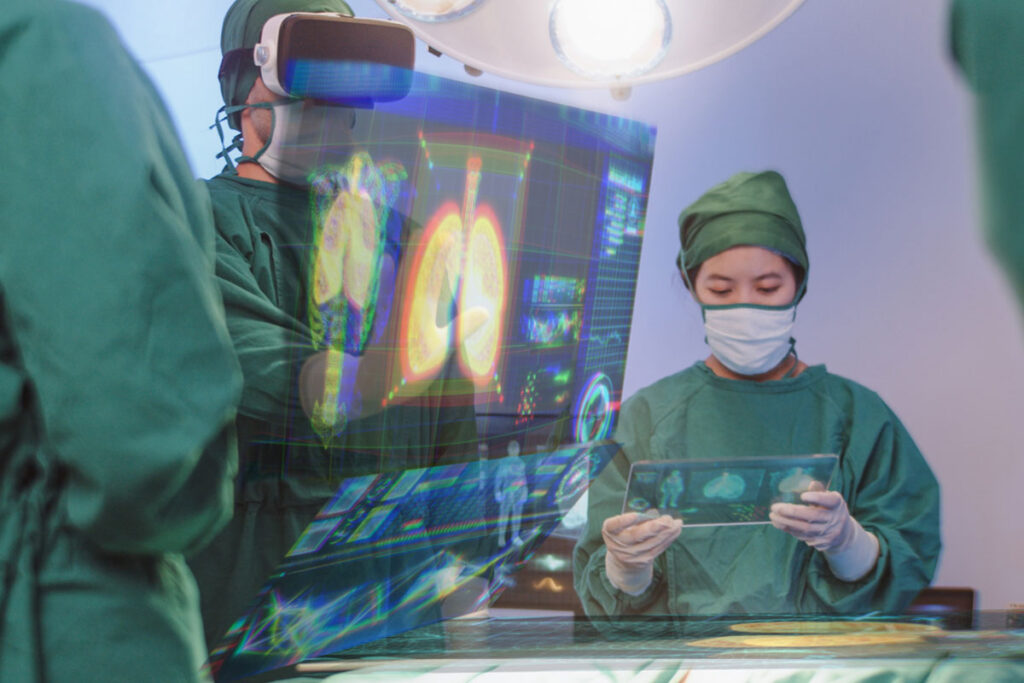With the rise of games like Pokemon GO, augmented reality has taken over the videogame industry by storm, offering new and exciting experiences for players worldwide. Augmented reality, however, isn’t just for catching Pokemon. While Augmented reality (AR) might sound like an empty buzzword, it can provide innovative solutions in healthcare, such as health education, training, and even helping visually impaired patients. Read on to explore exactly what AR is, why it is useful in medicine, and how it is making a difference in the healthcare world.
Defining AR and Its Place In Learning Tech
What is AR? While augmented reality might sound like a mind-bending technology reserved for the distant future, it’s becoming an important part of our lives right now. You have probably heard augmented reality and virtual reality used interchangeably, but they provide learners with very different experiences.
- AR: AR allows users to interact with the real world and computer-generated virtual elements at the same time. In AR, the virtual elements are often projected over physical surfaces, to combine the resources to enhance one another.
- VR: In VR, the learner no longer perceives their real surroundings; they can only experience a completely virtual, digital 3D world.
It’s Not Just For Finding Pokemon: Did you know that 40% of intravenous injections need to be attempted more than once, especially with children and the elderly? A recent AR Medtech startup called AccuVein helps nurses find veins more efficiently and accurately, making both the nurses’ and patients’ lives easier.So AR can improve the lives of healthcare providers and their patients, but what else can it do?
What Else Can Augmented Reality Do For the Healthcare Industry?
It can help pharma companies provide more useful drug information: Have you ever wondered how your medication works in your body? While you might have skimmed WebMD for answers, we bet you lost interest when confronted with boring and indecipherable drug descriptions. Now, augmented reality is here to help!
- With the help of AR, patients can explore how a drug or medication works in their body. Instead of reading long descriptions, learners can watch the process in 3D.
It gives surgeons x-ray vision: Doctors and patients know that when it comes to surgery, precision is vital. Whether a patient is receiving a minimally invasive procedure or undergoing something more serious, AR can help both doctors and patients feel more confident during surgery. Now, with Sync AR, surgeons can experience “X-ray vision” and closely monitor digitally enhanced images juxtaposed on surgical devices.
Many healthcare professionals today wish that they had VR during their training. Jilian, a Canadian doctor supported this in a recent interview with HospitalNews, stating “you realize that you’ll never encounter all of these different crisis scenarios in real life during your training, so this software would have helped put me in the hot seat to practice in a safe environment.”
Why is AR in Learning Tech Important?
It makes information more accessible for medical professionals: AR is here to replace bulky textbooks and charts with more streamlined, accessible info. ARnatomy, for example, helps medical students learn about bones and body structures by juxtaposing textbook images on the human body.
VIPAR (Virtual Interactive Presence in Augmented Reality) can also help medical students learn remotely from top surgeons. With VIPAR, surgeons can guide students during a procedure by projecting their hands into an AR display.
It helps patients get what they need: Every patient has different needs; especially children. An AR tablet has changed the pediatric world by measuring a child’s ability to stay still for an MRI exam. This tech helps doctors determine if younger patients need anesthetic during an MRI procedure.
Helping the visually impaired — With the help of AR, blind people or patients with visual impairments use VA-ST’s SmartSpecs to enhance the appearance of their surroundings, find lost items, and navigate using 3D recognition software.
Learning Tech For A Brighter Future
Now is just the beginning of AR technologies in the healthcare industry. As AR develops and becomes more affordable, more hospitals will be able to use it as an educational and treatment tool. Even the most experienced surgeons experience difficulties when operating on patients, and luckily with AR, doctors can work their way through different outcomes in real-time, and better prepare themselves for future operations. How do you think AR could help make both the patient and doctor experience safer? Share your thoughts and opinions with us here at WeLearn, because together we learn!

